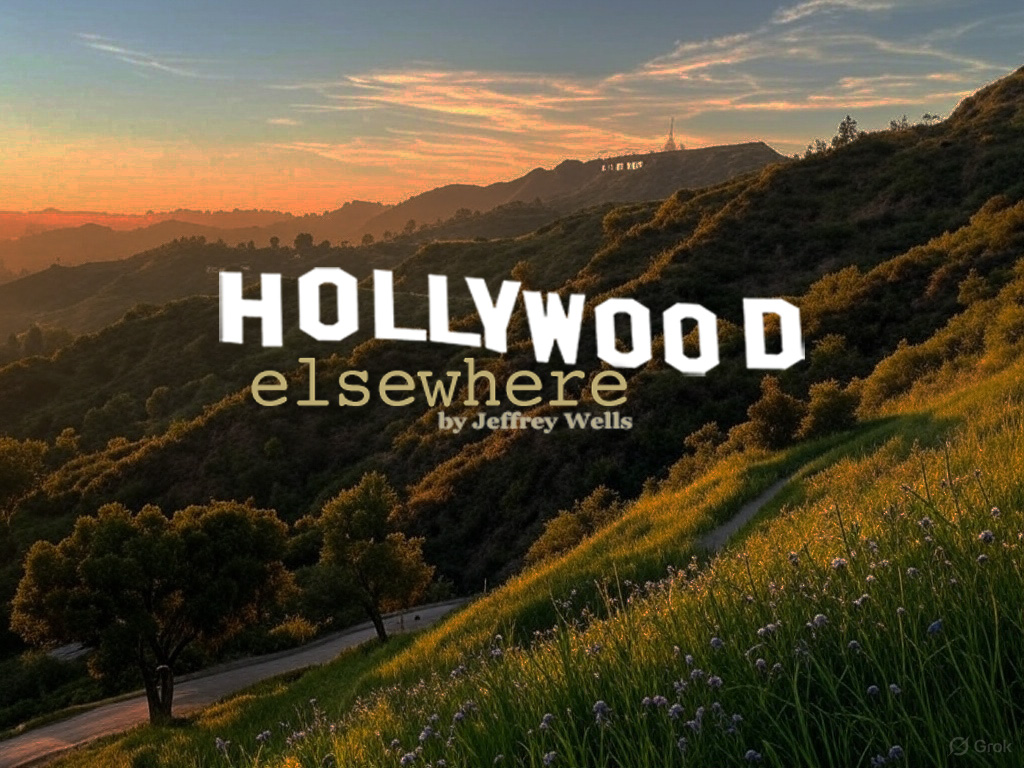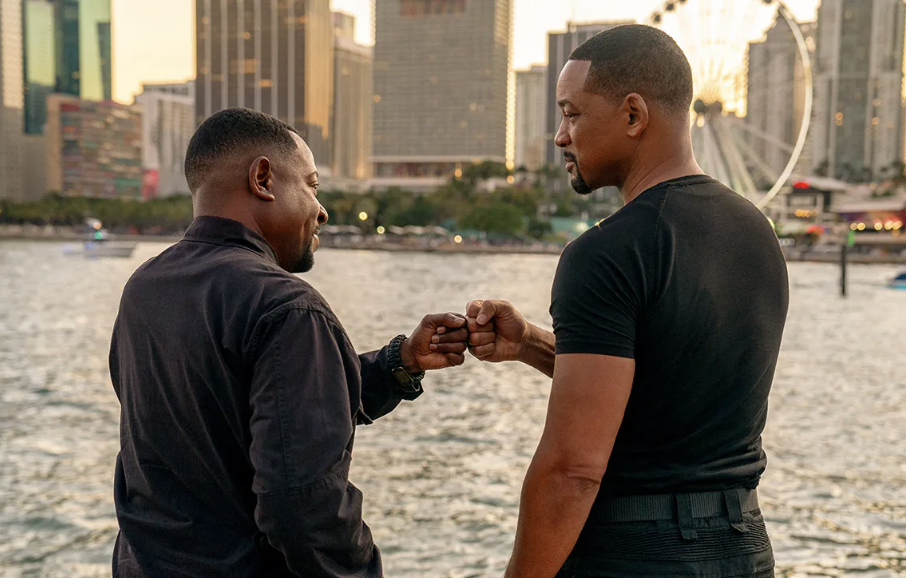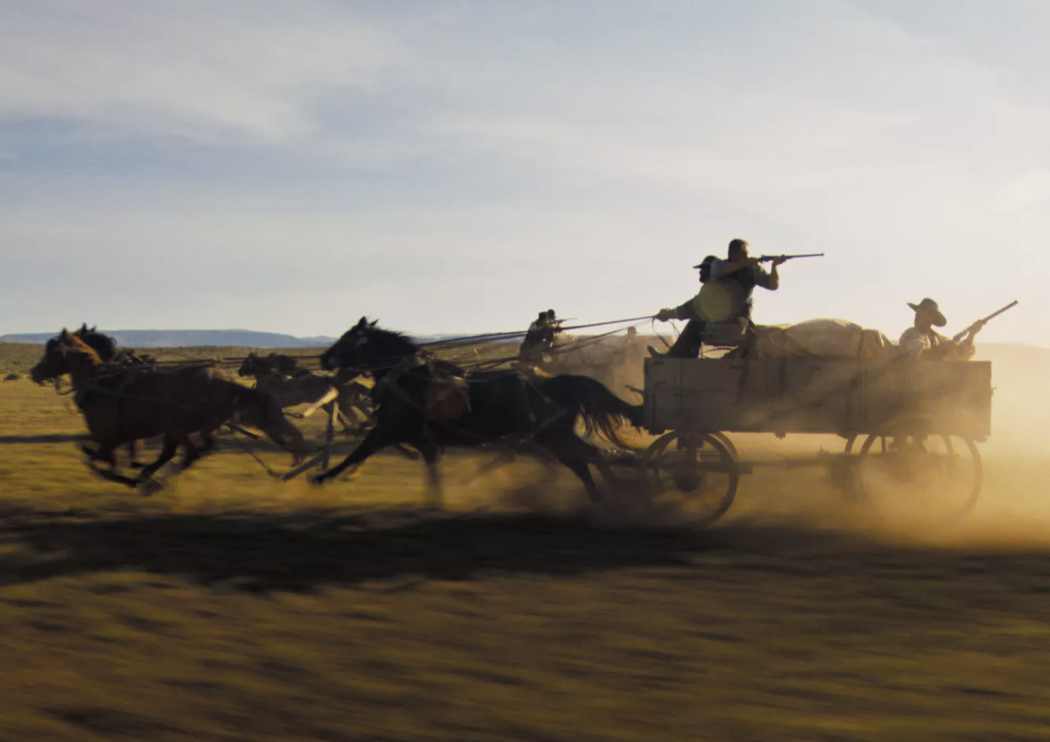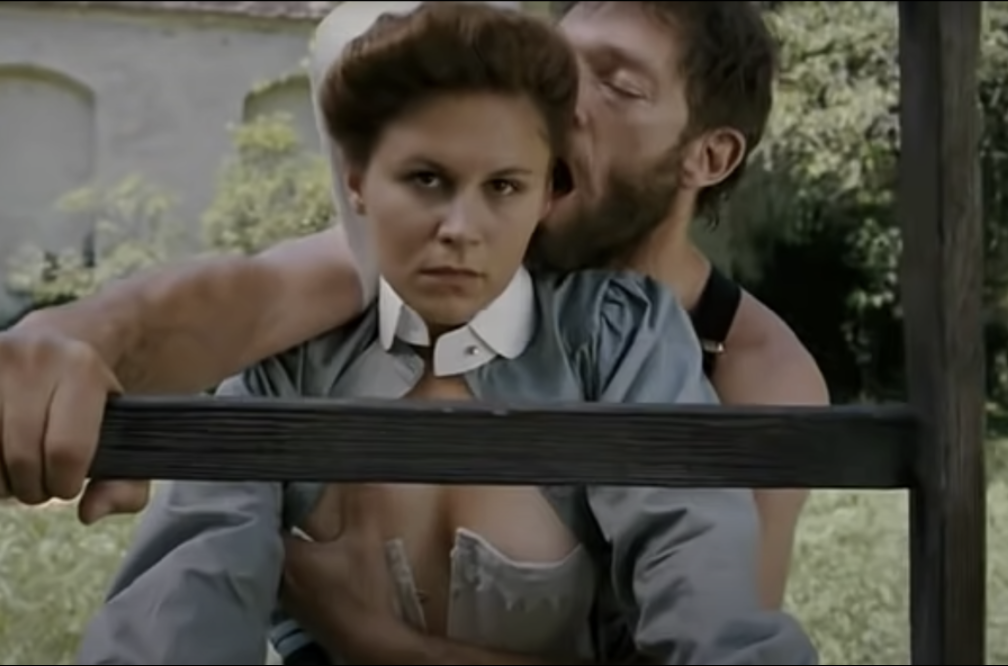Don’t you just love the American public? More specifically, the moviegoers (let’s just say it — those really deep women out there who read the tabs and are total fools for the Brangelina mythology) who just had to see the thoroughly rancid Mr. and Mrs. Smith to the tune of $51.1 million last weekend, and thereby rewarded director Doug Liman and stars Brad Pitt and Angelina Jolie for making the biggest piece of shit of their careers?? (Variety said that “boosting Smith were older femme adults, who don’t usually turn out for actioners but do read the celeb weeklies and watch tabloid TV chronicling the are-they-or-aren’t-they star pairing.”) Let’s just be happy that the Smith success makes it that much easier for the next grossly expensive big-studio piece of shit to get greenlit. And also that all of those wise and perceptive American moviegoers (most of them under 35, I’m guessing) also decided to blow off Cinderella Man last weekend (it was down 48% from the previous weekend). The story of Jim Braddock is basically a corpse now, just waiting to get picked up and carried out of theatres because so many millions of American moviegoers didn’t show up over…what? Russell Crowe’s phone-throwing episode? Because Ron Howard’s boxing film is too quality-skewed to compete in the mindless summer season? Because Univeral didn’t push the family angle heavily enough in the ads? A good movie is a good movie, darnitall, and every indication is that those who’ve seen Cinderellla Man really like and speak well of it. It just doesn’t add up that a movie as worthy and emotionally effective as this one would just stumble and run out of gas like this.
Russell Crowe’s career as an A-list star — i.e., a guy who gets the $15 million-or-higher fees and a first-look at the best scripts — is on the ropes. Despite his latest film Cinderella Man having gotten a 99% favorable CinemaScore grade last weekend, which means it has fantastic word-of-mouth behind it, Crowe’s recent telephone-throwing incident has so turned people off, it appears, that they’re pulling away from the 1930s boxing flick. How else to explain the fact that last night’s Cinderella Man earnings (for Friday, 6.10) of $2,848,000 were down over 50% from last Friday (6.3), when the Ron Howard film took in $5,905,225 on opening day? (Last weekend’s total was a less-than-expected $18.3 million.) What other possible reason could there be for a first-rate, very well-liked film dropping this heavily on its sophomore session? On the day of the Mercer Hotel phone-throwing incident a journalist wrote and said, “There goes [Crowe’s] Oscar nomination.” Now that Crowe has single-handedly turned Cinderella Man into a financial disappointment, it’s hard to avoid a suspicion that his ability to demand the big bucks may be in great peril. Hollywood hardballers are going to look at what happened this weekend and draw some very blunt conclusions. Then again, he is Russell Crowe, a great actor and a guy who can bring real gravitas and authority to a part. But if audiences are going to look at his films when they open and say, “Screw it, I don’t want to pay to see that thug” — like they apparently did this weekend — then he’s going to be making a lot less and he won’t be as much in the running for the best parts, and that means Crowe will probably be attending the IFP Spirit Awards next February and trying out his new indie cred.
Yesterday’s tracking figures on War of the Worlds (Paramount, 6.29) are through the roof — awareness is over 90% and definite interest is over 50%. For a movie that’s two and a half weeks from opening, this indicates something really big about to happen. This is almost Star Wars-level. Who knows? The Steven Spielberg-Tom Cruise collaboration could do $90 to $100 million in five days time.
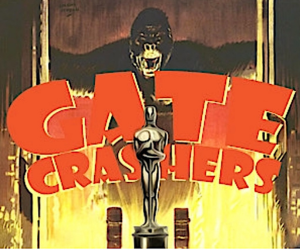
Best Batman
Christopher Nolan’s Batman Begins (Warner Bros., 6.15) is the smartest and most adult-minded superhero film Hollywood has ever made.
For the first time ever, a major studio has made a comic-book movie that plays it fairly straight and grown up without letting the usual downmarket distractions run the show.

Batman Begins is somewhere between exceptionally good and awesome during the first hour or so, which is what sold me and put me in a relatively placated and open-to-whatever place for the film’s slightly more conventional remainder, which — don’t get me wrong — is entirely decent and rousing and even spooky here and there.
I love the way Christian Bale’s Batman is always hunching over and scowling…this is one very pissed-off bat…and the general fact that Batman Begins is always a sharp, intelligent, well-written ride, and is exceptionally well acted by everyone.
< ?php include ('/home/hollyw9/public_html/wired'); ?>
Especially by Bale (in the dual role of Batman/Bruce Wayne), Michael Caine (Alfred the butler), Liam Neeson (Zen criminal Henri Ducard) and Morgan Freeman (Batman’s congenial tech-support guy Lucius Fox). It’s just pleasurable as hell when a movie is as well-cast as this one and nobody drops the ball.
I was even excited by Katie Holmes, who nails her part as a childhood friend of Wayne’s and a Gotham City prosecutor so nicely and skillfully that I momentarily forget about the bogus offscreen show she’s been putting on lately with a certain couch-bouncing actor.
But then at the very end, after the bad guys have been wasted, Batman is told by his plainclothes detective ally, Lt. Gordon (Gary Oldman), that there’s a new troublemaker on the horizon, a guy with a flair for the theatrical…
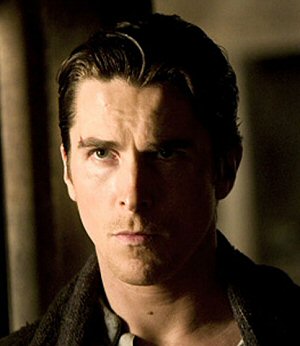
Christian Bale, star of Batman Begins.
And Gordon hands Batman a business card that says “Joker” on it, and my heart sank.
Nolan has saved the Batman franchise by taking it seriously and treating every aspect and line of dialogue and character like they really and truly matter without any Joel Schumacher attitude mucking things up, and for his Big Follow-up he’s going back to the old Batman vs. Joker routine?
Screw that, Chris. Create new villains, new perils…the hell with the damn comic book.
I thought this was going to be the Nolan Way when I realized the big threat to Gotham in Batman Begins is, believe it or not, mass psychedelic insanity…a gas that sends people into a state of instant hallucinatory psychological torment. This is way darker and stranger than the kind of material that Bob Kane, the original Batman comic-book guy, used in the ’40s and ’50s.
Well, enjoy this installment anyway. Batman Begins is the only comic-book superhero movie I’ve ever truly admired and enjoyed. And for a crabhead like myself, that’s saying something. I know a tiny bit about the original Batman comics, and that they never smirked or screwed around or cracked wise. This movie gets that, honors that.
Especially in the how-Bruce-got-to-be-Batman section, which is edited in a not-entirely-linear, time-flipping way that, for me, improves the delivery. Cosmetic improvements can really enhance a film if they’re well applied, and this is one such occasion.
This section is about overcoming rage and cynicism…about channeling energy and facing one’s fears. About Wayne getting past his parents’ violent death by blowing town and ending up in some snow-blanketed section of what appears to be northern India or Tibet.
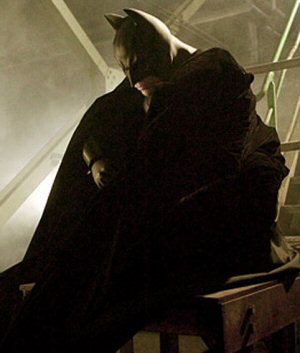
Here in Kundun-by-way-of-Insomnia country (surrounded by the same chunky bluish-gray ice fields that put the spell on Al Pacino) Wayne learns to be a hard-core opponent of evil from a team of gangster monks called the League of Shadows, led by Henri Ducard (Li am Neeson) and Ra’s Al Ghul (The Last Samurai‘s Ken Watanabe).
I love Nolan and co-screenwriter David S. Goyer’s decision to bring Neeson and his Zen goons back in the third act in a nicely symmetrical way. I guess what I really mean is that I love their not using some prancing-around supervillain to go mano e mano against Batman/Wayne.
I’m amazed, frankly, that a genre film this good came out of Warner Bros., a studio that encouraged and supported the anti-Christ Schumacher in the making of Batman and Robin and Batman Forever…movies that everyone despised and which showed, really, that Warner Bros. was kind of an anti-Christ movie studio, which is a harsh way of saying they couldn’t stop being clueless.
And then came all that ridiculous floundering around with Darren Aronofsky’s Batman: Year One and those different Superman movies (including one proposed with McG as director) and also that moronic notion of making a Batman vs. Superman film. It’s obvious these guys never had an idea what works, and still don’t.
Nolan’s pitch to Alan Horn about how to save the Batman franchise (which I read about recently) was probably approved with some kind of hunch on the way to lunch.
“Let’s see…everything we’ve tried to do to revive Batman and Superman has been a total embarrassment or a wipeout or has run out of steam,” Horn probably said to himself. “We look like total fools, the fanboys think we’re retarded…how badly can Nolan’s approach turn out, given our embarrassing track record?
“I don’t know if it’s a good or bad approach…I don’t know anything…but I know nothing’s worked so far so I might as well roll ’em.”
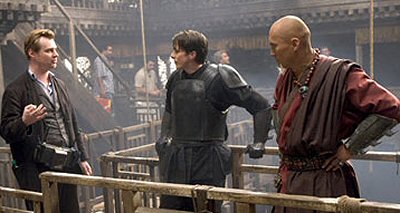
Batman Begins director Chris Nolan, Christian Bale, and Ken Watanabe.
Don’t get the idea that Batman Begins is anything more than a very smart and well-made programmer. It’s not Tokyo Story or highbrow suggestive like Val Lewton’s Cat People or anything in that realm, but it is high-quality merchandise because it digs in and tells a mythical, hyper-real story about people who think and behave with logic and reason.
Aside from Tom Wilkinson’s Falcone, a grossly mannered gangster guy, and 28 Days Later star Cillian Murphy as a double-dealing (make that drug-dealing) psychopath called Scarecrow. Both are a bit mannered, but then criminals in a comic-book movie can’t act like notary publics.
There’s plenty of action in this film, but it all flows from Wayne’s pain. I liked Bale for the first time in this role, and I say this having never warmed up to him before this. Nolan’s decision to have him bend over and get all raspy-voiced and rodent-like when he puts on the suit was inspired. Bale’s character is no smoothie. The ground he’s standing on is never that solid, and he’s just waiting for the next trap door to fall through.
Batman Begins is definitely breakthrough material. The fanboys are going to love it. It’s going to be fairly big and stay that way for, I don’t know, five or six weeks….maybe longer.
I’m glad I finally found a comic-book film I could stand behind. It’s a relief. I’m just sorry I was too backed up by Wednesday’s column to go see the IMAX version, which will surely be a trip in itself.
Bad Collars
I’m shocked — shocked — that there are guys out there who will walk into a Banana Republic tomorrow or next week and look at these shirts and go, “Cool…gotta pick these up.” Or a wife or girlfriend pointing them out to a significant other and saying, “Look…perfect for you.”
I shot these utterly revolting dress shirts two days ago at a Banana Republic in the West Village, on the corner of Bleecker and Sixth Avenue. I would go to jail before putting one of these on. It’s the bulky collars. They’re getting close to the size of those elephant collars of the `70s, so named for their resemblance to elephant ears.

Collars are for the wearing of ties. Without a tie they’re the stupidest and most pointless fashion accessory of all time, unless you’re X-factor and wearing some cool Italian-designed thing and the collars are narrow and delicate or in some way unobtrusive.
Clunky collars prove nothing, add nothing, accomplish nothing…and they’re ugly.
Tell this to the Ed Norton-Brad Pitt generation. These guys wet themselves over collars and zippers and shirts with absolutely horrible designs and rancid color schemes. I’m tellin’ you, men’s stuff was in a much cooler phase back in the late `80s…before the tastes of GenX Fight Club-bers started running the show.
Country Guy
“Thanks for mentioning my contribution to The Beautiful Country , since the Writer’s Guild arbitrated me out of credit, and when Pressman and Malick listed me as a producer they were threatened with a lawsuit for the sin of offering ‘consolation credit.
“That’s the Writers Guild for you, harming its own membership for as long as I can recall, but that, as they say, is another story.
“The project began as an idea of Terry Malick’s and was developed by Sunflower Films, a company belonging to Malick and [producer] Ed Pressman. I believe they had a low-budget overhead deal with Sony.
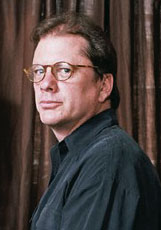
The Beautiful Country screenwriter Larry Gross.
“Sabina Murray, a published writer of fiction, had worked with Terry as a consultant on The Thin Red Line because of her expertise concerning events in Asia during WWII. She worked initially on the Wonderful Country script under the guidance of Zhang Yimou (Hero, House of Flying Daggers).
“Around this time Terry was offering Zhang post-production assistance on some of the smaller films he made in cooperation with Sony Classics. After a couple of drafts Zhang Yimou stepped away.
“Then Wayne Wang came on, and suggested that I rewrite Sabina’s script. I wrote a couple of drafts for Wayne, and then he stepped away too.
“Pressman, however, finally had a script everyone now liked. He had a list of indie and foreign directors with English-speaking experience or credentials, and Hans Petter Moland was on the list.
“I had just been at Telluride and seen Moland’s superb Aberdeen, a dysfunctional family drama, with Stellan Skaarsgaard, Lena Heady and Ian Hart. Moland had also been responsible for launching Skaarsgaard’s movie career in Scandinavia with a naturalistic period action film called Zero Kelvin.
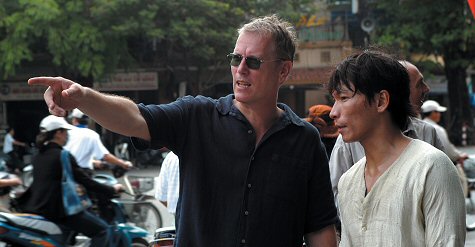
The Beautiful Country director Hans Petter Moland, star Damon Nguyen during filming.
“Moland is a filmmaker of wide humane interests and tremendous skill I recommended him avidly to Pressman. Terry screened Aberdeen and promptly told Ed that Hans Petter Moland was the guy who should do this.
“It took two years to get the money. And it was a ridiculously tiny amount of money to make so physically arduous a film.
“The element that stayed firm and true to the project from before my involvement, I`m forgetting to mention, was Nick Nolte. I think his fifteen minutes at the end is some of the finest work in his glorious career. The most recent bit of comparable stature was his superb part in The Thin Red Line. Obviously he and Terry have a connection;
“Again, thanks for supporting the work.” — Larry Gross (also screenwriter of We Don’t Live Here Anymore, the excellent Gunshy, Crime and Punishment in Suburbia, 48 HRS.
Rent
“Great riff on the new Rent trailer, although I have to say I share your fears about Revolution Pictures (i.e., the can’t-get-it-right Joe Roth) and Chris Columbus having their mitts on this one.
“This was arguably the best musical of the 90s. It helped to push the boundaries of what the mainstream could digest in that wonderful pre-millennium time. The rawness of the piece just might be best suited for the dreary Nederlander Theatre. Time will tell if it translates to the screen.
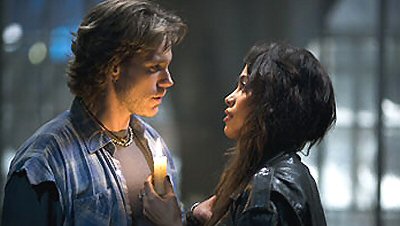
Adam Pascal, Rosario Dawson in Rent, due Nov. 11 from Columbia.
“I am encouraged that 90% of the original cast is back to do the movie. If they can bring one tenth of the energy to the screen that they brought to the stage, they might just push the film to the fresh side.
“I will say this: the Rent trailer is the best music video I have seen this year. (Not that I watch them anymore.) You are 100% right — Jonathan Larson wrote a beautiful song in ‘Seasons of Love.’ The cast knows it, the audience knows it — I just hope Columbus can do the whole thing justice.” — Brendan Noone
Smith Shame
The only significant addition to the Mr. and Mrs. Smith roster of shame, announced two days ago in this space to try and hold certain critics accountable for liking or giving even a mixed pass to Doug Liman’s action thriller, is Jamie Bernard’s review in the N.Y. Daily News.
Smith Agonistes
“I was so happy to read your reaction to Mr. and Mrs. Smith. Perfect. I haven’t seen the film itself, but I saw the trailer, and that was all I needed to see. Ever.
“I’m so tired of films that not grounded in reality. It seems like 90% of all action movies have to have The Matrix style of effects, without being in a sci-fi world that would allow any of it to be remotely plausible. The action is so ludicrous that it takes me right out of the picture.
“The real stunner is that Doug Liman would resort to the McG school of filmmaking. Why, why, why?!? There are so few directors that can lay down a quality, gritty, realistic action picture, and Liman is, or at least was, one of those guys. It’s an awful waste of talent, and it’s disgraceful for him as a filmmaker.
“I know that people eat this crap up, as I always hear the classic line `the story was o.k., but the effects were really great.’ It kills me. I really, really hope this thing tanks.” — Jeff Horst
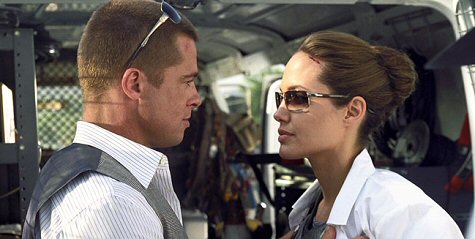
“I’m beginning to develop this theory that marquee-level critics in the last 10 years seem to have resigned themselves to the realization that certain films are critic-proof and to attack them is a fruitless Tar Baby exercise.
“Films like Mr, and Mrs, Smith may have their merits, but we all know if they starred the guy from Law & Order: Special Victims Unit and one of the chicks from Charmed instead of Brangelina then all those 13 to 35 year olds would deny it the $45 million opening it will most probably earn and just make it an X-Box weekend.
“Certain critics apparently have a `choose your cinematic battles carefully’ attitude when it comes to major studio releases. The worst offender seems to be Roger Ebert who has given a pass to a veritable sewer of shitty films.
“I mention this because I was thinking of the reaction to the Mr. and Mrs. Smith trailer I witnessed on opening day of Revenge of the Sith. In a crowd of Summer ’05 blockbuster-to-be trailers that included War of the Worlds and Fantastic Four, the loudest reaction was for the Smiths, so be prepared for more positive reviews.” — Steve Coppock
“The overriding thought I have whenever I see a promo for Mr. and Mrs. Smith is not that it’s about gorgeous people acting out their fantasies — shooting guns, doing stunts, not acting but play-acting the way children do. What I think of is what Hitchcock could’ve done with the same basic premise.
“Instead of allowing Carole Lombard to hornswoggle him into directing a rather tepid domestic comedy, imagine he and, say, Ernest Lehman, coming up with a black comedy centered not around big guns and explosions, but a couple surreptitiously and cleverly trying to kill each other, all the while remaining polite to each other’s faces and never admitting openly what they’re up to.
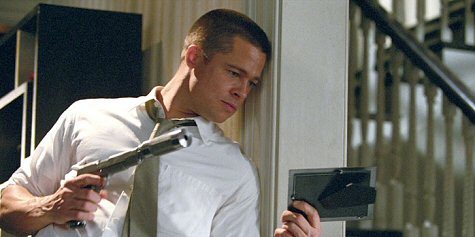
Brad Pitt
“Of course, at the end, after one of them finally, perhaps even accidentally, dispatches the other, he or she sits down to eat the sandwich and glass of milk the other one so courteously laid out for them.” — David Ludwig.
“I agree with you on this movie. There is no way I am seeing this thing. It seems to me that the director knew of the happenings between Pitt and Jolie, and he used that chemistry (if there is any) to try to make the movie slicker, because people are going to see it just to check out said chemistry between the two.
“I also can’t help thinking about True Lies. They just made the Jamie Lee Curtis part as a spy. How many people would like to see Ms. Jolie in the bedroom dance scene from that movie?” — Gil Padilla, Dayton, Ohio.
Alien Confusion
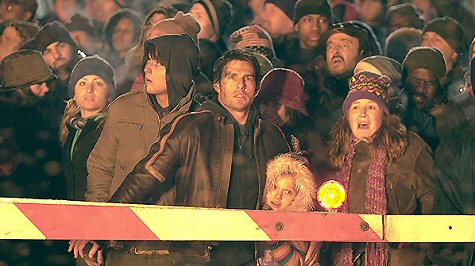
Werner Herzog
“It’s been a while since I’ve actually laughed out loud at something I had read online, but your piece about that War of the Worlds picture made me do just that this morning. Thanks for that — made my day. ” — Jeremy Wockenfuss
“I always love your stuff, but there’s something wonderful and, I dunno, vaguely magical about your breakdown of that War of the Worlds publicity photo in [Wednesday]’s column. Every face you describe just makes the description you’re writing a little more perfect, until you’re no longer just making a point, you’re creating a perfect little work of art. That’s really beautiful writing, man.” — Name lost in the shuffle
“Your description of that War of the Worlds still is hilarious! I love that you caught that girl smiling behind Tom Cruise. Also love the NYC shots you’re putting in – I miss it there. ” — Sharon Mann, Paris, France.
Grabs

Not an all-girl restaurant, appearances to the contrary. Tartine on West 4th Street — Wednesday, 6.8.05, 7:35 pm.

West 4th Street near Charles — Wednesday, 6.8.05, 7:20 pm.
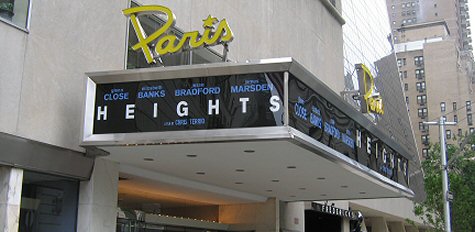

There’s a Whole Foods on 14th street in Union Square — full of exquisite pickings and a great salad bar and costly as hell. (The nickname, I’m told, is “Whole Paycheck.”) I was there the other night and filled up one of those plastic trays full of salad and vegetables, and was told by the cashier that I owed them $20. I’ve never paid $20 for a salad in a restaurant. Le Basket (pictured above) is about four or five blocks south of Whole Foods with a nice salad bar of their own, and they only hit you for about $10, so Whole Foods can bite me.
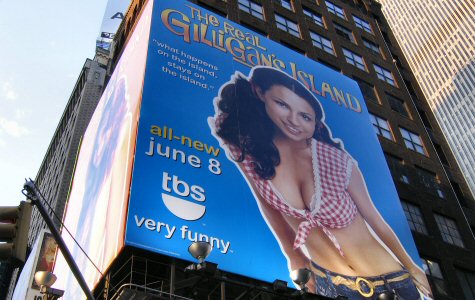
Northeast corner of Broadway and 47th — Thursday, 6.9.05, 6:10 pm.
Dragon
“I remember seeing Year of the Dragon when it came out and enjoying it. It became a guilty pleasure of mine. I rented it a couple of times over the years and always enjoyed the performances of some of the supporting actors (Raymond Barry, Caroline Kava).
“Mickey Rourke’s hair is quite strange, but what also is curious is the noticeable sore on his nose, which changes shape and size depending on the scene.
“And Ariane, giving the worst performances by an actress in the history of movies.
“And Rourke’s salty language in front of couple of old Nuns. And the old character actor who I remember being on Barney Miller speaking through what Howard Stern calls a ‘cancer kazoo.’
“And Rourke interrogating a chinese gangster girl that he’s just shot (‘Look, you’re not gonna make it.’) It’s the gift that keeps on giving.” — Sean Griffin
Litter
“As a lifetime New Yorker, I was amused by your comments about the garbage littered sidewalk … Please realize, nobody in NY gives a crap about anyone or anything but themselves. The only ones who can be nice (and its rare) are the tourists who don’t know any better.” — Ron KofflerCinderella Slogan
“When the country was on its knees, he threw a telephone at its face.” — Kevin Kusinitz, New York, NY.
“I think the real problem is the title. Cinderella Man reads to your average moviegoer like a film about a transvestite. People equate Cinderella with the fairy tale who’s main character happened to be a female. It’s not that people are stupid but in today’s headlines about Michael Jackson it subconciously has a negative vibe.
“I don’t care for the title either mainly because it comes off too cloying or clever.” — Steven Hanna, brother of Detective Vincent Hanna, LAPD….keeping on the edge, with his angst, where he needs to be.

Werner Herzog
“The problem with the punchdrunk ad syntax for Cinderella Man is that it goes from a generalization to a specific, in essence choosing one out of many possible paths, and calling undo attention to itself as a result.
“Simply by switching it so the specific flows into the generalization, there is no subliminal ‘surprise’ and it is less disorienting, such as: When America was on its knees, he brought the country to its feet. Although, that said, ‘When America was on its knees, he brought the nation to its feet,’ is somewhat better focused, and ‘When America was on the ropes, he found the strength to inspire the nation,’ gets rid of that bothersome sexual double entendre.” — Doug Pratt DVD Newsletter.
“The reason for the repetition of `country’ and `America’ in the Cinderella Man slogan seems pretty straightforward to me. The marketing guys want to make the movie sound as broadly-appealing as possible and connect it to a certain patriotic sentimentality, so the word `America’ has to be in there somewhere. But at the same time, people don’t want to think of `America’ as being on its knees, implying that America is weak. So they have to make it abstract, substituting a pronoun, and making the sentence awkward.” — Jason Edgecombe
Herzog
“Just read your excellent article on Werner Herzog. I’ve been an authentic fan of his ever since seeing Aguirre, the Wrath of God many years ago in San Diego. I lend this movie out whenever I can and to whomever I can, but always with the caveat that the movie be watched without interruption at a time when there is no chance of being too tired to pay adequate attention.
“But I’m writing to say how pleased and surprised I was to read the following which you wrote, `Herzog’s films should not be rented — they should be owned and pulled out every few months and not just watched in a social way with friends but seriously absorbed in a state of aloneness…like meditation, with incense burning.’
“Never were there truer words said on any subject under the sun. I thought I was strange admonishing my friends the way I described, but you’ve given me vindication. The paragraph above perfectly describes how I feel about Herzog and Aguirre especially. It took me by surprise, it was so on the mark.” — John Rosen.
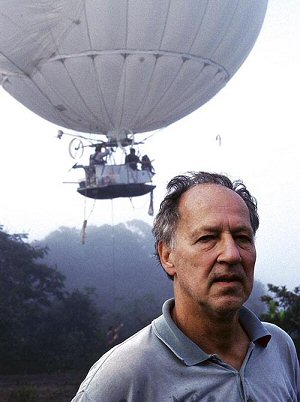
Werner Herzog
“Thanks for the piece on Werner Herzog. Thank God that there are filmmakers like him — filmmakers with vision and passion still plugging away. In this age of loud, empty, mindless, obscenely expensive, loud, dumb films there is at least one filmmaker who, as you say, `cares more about getting viewers to trust their eyes … or more importantly their dreams.’
“How many filmmakers today are as obsessive, or crazy as Herzog to follow their vision to completion, like he did with Fitzcarraldo? I’ve been a fan ever since Aguirre, the Wrath of God, but unfortunately haven’t seen any of his documentaries. I’ll take your advice and head to the video store to purchase one of his docs and relish it. Then I’ll have to decide which of his narrative films to purchase; one that my family, who don’t care for foreign language films, should see. If they only knew the glut of riches they were missing out on.” — Edward Klein, Salem, Oregon.
“Cheers for your Herzog plug. I’d also recommend some other of his older documentaries, particularly Lessons of Darkness. On the feature film front, the recent Herzog/Kinski box set is a showcase for the (arguably) greatest director/actor pairing ever.” — Laura Clifford, Reeling Reviews.
Grabs, Part 2

Extra Virgin, 259 West 4th Street. Appetizers, $6 to $12, Entrees from $17 to $19. All major credit cards.

Waiting for L train in Union Square station — Thursday, 6.9.05, 10:05 pm.

West 4th near Jane — Wednesday, 6.8.05, 7:50 pm.

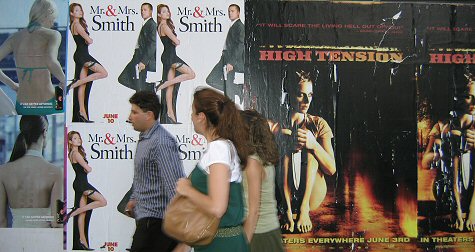
Thanks to the good, gracious and supportive readers who’ve tossed me some loose change over the past three or four days, in response to my request for help (see upper left ad box) in getting through a proverbial bad patch. For those of you who can’t pitch in, don’t sweat it…your steady readership is what really counts. For those thinking of doing so …well, whenever and whatever. But thanks again to everyone.
The fanboy community freaked last week when 20th Century Fox announced their decision to hire Breet Ratner to direct X-Men 3. Ratner will of course degrade the franchise. Not in any thuddingly obvious way but in a hundred little ways. One of these is his decision to add more laughs. “Not jokes for the sake of jokes,” Ratner said in a recent interview, but “jokes that come from character humor, that come from characters and that come from the situations.” This sounds to me like a guy saying he doesn’t entirely get (much less get off on) the X-Men mythology or metaphor, and that he’s a tiny bit bored by it so why not throw in some more gags? As Red Dragon was to Silence of the Lambs, X-Men 3…we know how this sentence ends, dont we? X-Men 3 will begin shooting in Vancouver in mid-August.

Did I miss the news about Tommy Lee Jones’ The Three Burials of Melquiades Esrada finding a U.S. distributor, or are Jones and his producer Michael Fitzgerald still hunting around for the right match? The latter, apparently…but shouldn’t this obviously worthy drama (several reviewers in Cannes called it a great Sam Peckinpah film) have found a distributor by now? It’s a fairly safe bet it’ll be an award nominee (Jones took the Best Actor prize in Cannes, on top of Guillermo Arriaga winning for Best Screenplay) if it comes out in October or November. It’s probably the usual-usual (producers asking for more money than distribs feel it’s worth, etc.) but if anyone knows anything solid, please get in touch.
There are two things that scare me just a little bit about the upcoming movie version of Rent (Columbia, 11.11), the phenomenal mid ’90s Broadway musical that was based on Puccini’s “La Boheme.” The first is that Joe Roth’s Revolution Pictures produced. Roth has shown such lousy instincts and has built such a terrible track record that the word “Revolution” is, in a Hollywoood context, pretty much synonymous with stinker. The second concern is that Rent was directed by Chris Columbus, a nice-enough guy who likes to sentimentalize and sugar-coat everything he shoots. If there’s a way to overly-sanitize and prettify and otherwise screw up a musical as good and vibrant as Rent, Roth and Columbus are just the guys to manage it. That said, the Rent trailer is awfully good. It’s mainly the cast (Rosario Dawson, Adam Pascal, Taye Diggs, Idina Menzel, Jesse L. Martin, Wilson Jermaine Heredia) singing the beautiful “Seasons of Love” as we’re given a standard montage of sad-joyful scene clips and a slight taste of the sad-joyful storyline. Even with Columbus behind the camera, it made me wonder — it planted the idea in my head — that this might be as good as Milos Forman’s Hair. If nothing else it reminded me what a good song “Seasons” is.
I’ve dipped into this twice now, but that item I ran last Thursday (6.2) about Paramount’s not wanting to green-light Mission: Impossible 3 unless Tom Cruise agreed to scale back his 30% gross revenue deal has been verified by a report in today’s (6.8) Los Angeles Times saying that the film is now set to go and what put it back on track was Cruise’s willingness to take “a major pay cut, giving up what could amount to tens of millions of dollars.” Cruise agreed to take 22.5% of the gross instead…big concession! Reports
have said that Paramount chief Brad Grey has haggling with Cruise for the last week over this matter. I ran an assertion last Thursday from a connected insider saying the M:I3budget was nearing $180 million, and now the Times story has said that Paramount insiders are placing the figure at $185 million. The film will start shooting in mid July and hit theatres next summer.

Extremities
Werner Herzog, perhaps the greatest poet-documentarian of our time and certainly one of the world’s most go-for-broke filmmakers, is seeping into my inner places left and right.
I saw his latest documentary, the touching and very beautiful The White Diamond, which Herzog is self-distributing, at Manhattan’s Film Forum last Saturday.

The great Werner Herzog, now 63, and the teardop-shaped helium-filled flying contraption that is the ostensible focus of The White Diamond.
Press screenings of Herzog’s Grizzly Man, which I saw 90% of at Sundance last January, are happening in New York in support of the film’s August 5th release from Lion’s Gate.
And the still-fascinating Burden of Dreams, the 1982 Les Blank documentary about the making of Herzog’s Fitzcarraldo, came out on a Criterion DVD just about a month ago, and I happened to see it last weekend.
To see these three films in a row is to be reminded what a truly great life-gulper, risk-taker, nature-worshipper and madman Herzog is.
< ?php include ('/home/hollyw9/public_html/wired'); ?>
There is no filmmaker I know of who cares more about getting viewers to trust their eyes (which almost no one does anymore, he says, quite accurately, since special effects began to dictate visual terms to action-adventure film starting about 25 years ago) or, much more importantly, their dreams.
There may be filmmakers out there who are more earnestly committed to a particular vision of things or more determined to express cinematic worship about all things natural, eternal and transcendent than Werner Herzog, but I don’t know who they are.
Herzog’s films should not be rented — they should be owned and pulled out every few months and not just watched in a social way with friends but seriously absorbed in a state of aloneness…like meditation, with incense burning.
Except for The Mystery of Kaspar Hauser, which I’ve always found slightly hateful, I know that Herzog’s films have always had a jolting head-turning effect upon me and the way I look at movies.
The White Diamond is about Herzog going back to the South American jungle, like he did in Aguirre, the Wrath of God some 33 years ago with his “best fiend” Klaus Kinski, and again for Fitzcarraldo.
The place this time is the rain forest in Guyana, in northeastern South America, and the risky activity (which there usually is in a Herzog doc) is flying in a helium airship above the treetops with a British engineer named Graham Dorrington.

The movie is about Herzog wanting to capture whatever he can in this hallowed environment, especially as it relates to the purity of the non-technological, anti-intellectual lives and customs of the natives as well as the wonder of the rain forest itself.
It’s also about Dorrington wanting to somehow to work through and maybe exorcise the guilt he feels about the death of a friend named Dieter Plage, a German cameraman who met his demise after falling out of a similar Dorrington-made helium airship in Sumatra in 1993.
Neither vein proves entirely cathartic, but I didn’t care because the movie still put me into a mystically spooky, deeply beautiful jungle environment with Herzog trying to touch and uncover wondrous things, and sometimes deliberately not uncovering them.
The spiritual epicenter of The White Diamond is the glorious footage of Kaieteur Falls with its urine-colored water plunging over the crest and creating magnificent mist clouds below…all mighty and roaring and wonderful for simply staring at for hours.
Below and behind the falls is a vast cave where thousands of swifts — white-breasted birds with broad wing-spans — mate and nest and hang. There’s a stunning sequence when one of Herzog’s guys is lowered down to a position where he can shoot into the swift cave.
Herzog is later told by the locals that including this footage in the film will somehow intrude upon the spirit of the falls and violate its other-ness on some level, and so he doesn’t show us the swift-cave footage, and this somehow becomes more fascinating than if he had.
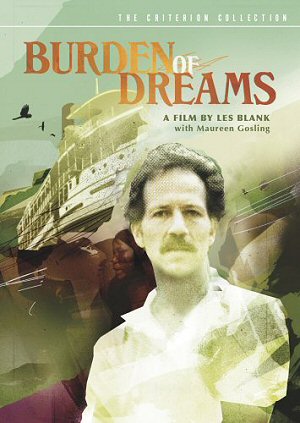
I didn’t mention earlier that there’s a third Herzog documentary about devotees of eastern mysticism (made a couple of years ago, according to the IMDB) called Wheel of Time, which will apparently open on or around June 15.
And there’s an ’05 Herzog film called The Wild Blue Yonder in which Brad Dourif “plays” an alien, although the film is described on the IMDB as a documentary.
Readers living in the boonies should at least buy or rent Burden of Dreams (it’s easily available through Amazon.com) and then grab the docs when they hit DVD, which should be…well, I don’t know exactly but I would think sometime later this year or in early ’06.
Shame
It takes all sorts to make a world and anybody can like any movie for any reason…we all know this. It’s all subjective and there are no absolutes about the goodness or badness of anything…except in the case of a film like Mr. and Mrs. Smith.
A movie this repugnant calls for drastic measures. The usual critical civil liberties need to be put aside. A kind of aesthetic martial law must be temporarily imposed.
This film is a discharger of a certain rancid corporate nerve gas that has been affecting our culture and our souls, and the regular readers of this column know what I’m talking about. It isn’t just bad — it’s putrid.

As New Yorker critic David Denby writes, Mr. and Mrs. Smith stars Brad Pitt and Angelina Jolie “are so pleased with themselves [in this film] that audience approval seems almost superfluous.” To me they seem smug and arrogant the way certain too-beautiful guys and girls used to seem back in high school…you know the ones I mean. The ones with the big smiles and too-white teeth and too-carefully-chosen clothes we all used to faintly scowl at as we passed them in the hallways.
It’s also one of the saddest examples of Mephistopholean corruption of a once-clever and noteworthy director (Swingers, Go and Bourne Identity helmer Doug Liman) in a long time, and it will poison or at least pollute the popularity wells of Brad Pitt and Angelina Jolie for months to come…mark my words.
It is just too vile and repellent a film to be winked at or shrugged over, much less be given a rave or even a pass because (clever idea!) it uses gunplay as a substitution for sexual foreplay and an exercise that re-ignites desire in a marriage gone stale.
It is therefore unacceptable for A-grade critics (i.e., elite writers for the big publications who’ve shown they’ve got some good chops and serious film knowledge) to put on their tap shoes and figure some way to air-kiss this film. Approving of Mr. and Mrs. Smith is just wrong, doing so is bad politics and bad voodoo for film critics and film lovers everywhere, and it cannot be condoned.
At the risk of sounding like Sen. Joseph McCarthy of Wisoncsin, I feel obliged to keep a watch on any well-respected critics (I’m leaving out the junket freeloaders, easy lays and less-well-knowns) who decide to tumble for this thing over the next few days. Hopefully the world will take note of this.

As well as disregard explanations like the one put forward by the Philadelphia Weekly‘s Sean Burns that Mr. and Mrs. Smith is making an anti-materialist argument. The film is saying “that the rituals and commodities we’re all programmed to associate with a stereotypical happy marriage turn out to be the very obstacles that keep couples from truly knowing one another,” according to Burns, and that “only by trashing the paradigm (and literally blowing up the McMansion) that we’ll finally start seeing the other person for who they really are.”
Good God…this is precisely what I’m talking about! The fact that there isn’t the faintest hint that anyone involved in the making of Mr. and Mrs. Smith had the slightest awareness of such a theme should have, at the very least, given Burns pause.
The names so far on the Mr. and Mrs. Smith roster of shame are Burns, Michael Rechtstaffen of the Hollywood Reporter, Newsweek‘s David Ansen and New York magazine’s Ken Tucker .
Not Quite Right
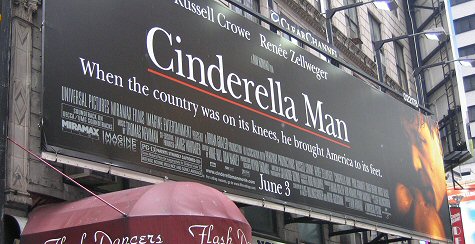
West-facing billboard on Seventh Avenue near 52nd Street.
The advertising slogan for Cinderella Man is making me wince every time I read it, and I love the film so it’s not like I’m looking for trouble.
It’s just that the rulebook says there’s no using the same noun, even if you use different terms for it, twice in the same sentence.
This is why Lou Reed never wrote “when the smack begins to flow the heroin starts to feel really good.”
Of course, ad guys have never been that concerned about bad writing.
How should it read? I read an earlier version on a poster somewhere (or in a Variety ad) that said, “When the country was on its knees, he brought us to our feet.” That almost works. Or: “When the country was on its knees, he made everyone stand and cheer.” Hmmm…
If anyone has a better one, send it along so I can run it Friday.
Distractions
This is the funniest terrified-crowd-reaction shot I’ve ever seen that comes from a presumably scary movie.
Almost everyone in this War of the Worlds shot is expressing some slightly different emotion or reaction…they’re all off on their own trip. It’s almost as if the photographer said to them, “Okay, now remember…nobody is allowed to look in the same direction or exhibit the same anything…got it?”
Starting from the extreme left, we’ve got a woman in a hat showing us her right profile and talking to an invisible friend. Behind her and slightly to her right is a serene-looking bearded guy in a skull cap who’s thinking about his career or maybe what restaurant to take his girlfriend to later on. To his right and slightly in front is the blonde girl with the knit cap who looks more spaced than scared.

Behind Tom Cruise’s right arm is a young kid in a hooded sweatshirt (resembling a young John Cusack) who’s looking up and to his right and going, “Uhhh…whoa.” Then you’ve got Cruise looking slightly up and straight ahead and properly alarmed. Next to him is Dakota Fanning reacting to a signal from her agent that he’s just gotten her another role as a really cute, whip-smart little girl in another big-budget movie.
Next to Fanning is her mother (and Cruise’s wife) Miranda Otto, who’s reacting to a very scary something-or-other that no one else is quite focusing on.
To Cruise’s immediate left (and mostly in his shadow) you’ve got a young woman who’s smiling at one of the aliens. Then way behind her is a black guy in a skull cap who looks bored. To his right is a middle-aged guy reacting to some kind of anal probe. Then you’ve got another black guy behind Otto and slightly to her left who seems perturbed about life in general….or is he smirking?
So everyone is looking at several different aliens or alien ships, or it’s just one of those stills that shouldn’t have been released but it was anyway because everyone was in a huge hurry to get War of the Worlds done in time for the 6.29 opening.
Dead Smiths?
“I attended a media opinionmakers screening Monday of Mr. and Mrs. Smith, and for the most part the silence was deafening. There may be some curiosity business the first weekend, but does anyone actually think this film has legs?
“Frankly, even Xanadu and Charlie’s Angels: Full Throttle got better reactions from what I can remember — and I saw both of those at similar screenings.
“The audience was willing to buy the Smiths for the first 40 minutes or so, when it looked as if it was going to be a dark domestic comedy. But when it exploded (literally) into full-blown action mode, you could sense a definite disconnect. No applause at the end although the last session with the therapist earned a few giggles, and not many positive comments on the way out.
“Three hours later, I saw Batman Begins and the reaction was the absolute reverse: Everyone seemed caught up in the film from beginning to end (and they did applaud on the way out). My guess is that whatever biz Mr. and Mrs. Smith is going to do is going to happen this weekend — and the money machine is going to conk out abruptly next Wednesday.” — James Sanford.
Moments

Tenement buildings between 5th and 6th streets on Bedford Avenue, Brooklyn — Sunday, 6.5.05, 6:10 pm.

Looking south down Seventh Avenue from northeast corner of 53rd Street, a half-hour or so before Monday evening’s Batman Begins screening at WB’s very covertly located screening room, which has a Sixth Avenue address but is actually about 75 feet to the east of 7th Avenue on 53rd Street.

Clean streets and sidewalks are an indicator of neighborhood pride and self-esteem. Clearly the residents of the Bedford district’s south side (near south 5th Street and Driggs Avenue) have a little ways to go. If all this crap were lying on the sidewalk in front of my building I would get a Hefty plastic garbage bag and pick it up and throw it in the dumpster. Where is the dignity with these people? Obviously somewhere else.

Sherry Netherland hotel (older building, right) and Hotel Pierre to its left. Pic taken from area near the eastern entrance to the formerly alive and pulsing Plaza Hotel, which is being turned into condos for the grotesquely rich…terrific. Another pat on the back for George Bush and his efforts to restrict middle-class opportunity and let the super-rich go hog wild and turn the pricier sections of this country into a super-rich pigpen. And another big pat on the back for those red-state security moms who voted him in…very wise, ladies! Completely contrary to your own financial interests plus the 911 Commission guys are saying they don’t believe that the Bushies have done all they can about preventing another World Trade Center catastrophe…so voting for Bush just made loads of sense.

Looking west on 57th Street from Sixth Avenue, just as Monday afternoon’s rainstorm was about to begin — 6.7.05, 4:15 pm.

Sixth Avenue bus stop during Monday afternoon’s cloudburst — 6.6.05, 4:20 pm.

Taken from Sony corporate headquarter’s 7th floor after screening of Sony Classics’ Heights, which wasn’t half-bad — 6.5.05, 3:00 pm.

Sixth Avenue again, from entranceway to Starbucks during that same old rainstorm you’re now starting to get tired of hearing about — 6.6.05, 4:17 pm.

Approaching Marcy Street subway station in another enterprising but vaguely shitty area of Brooklyn. Just after taking this I was walking past some low-rent cheeseball hot-dog stand with my Canon camera in hand, and I must have looked like a tourist because a couple of guys who looked like close relations of R. Crumb’s Weasel J. Weisenheimer gave me a look that said, “Whoa…can we take this guy? We could get that camera.” I gave them a Dirty Harry look that said, “Go ahead, try it.”
Swimming Pool
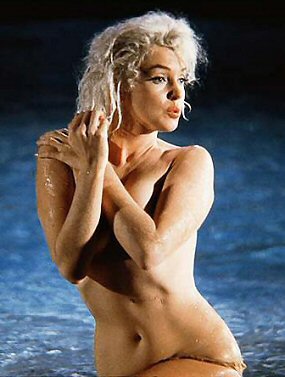
There is rarely a work day (or any day, because I’m online every damn day no matter what, including holidays) when I don’t click on this photo and think about how the water would feel.
When I wrote about Russell Crowe’s phone-throwing altercation a couple of days ago I suggested that the hotel employee who got hit by the phone might have been giving Mr. Fistbiscuit an attitude of some kind. I was being sincere, and I read a statement from Crowe’s rep that the hotel guy was being a bit of a dick. Then I said that “the hotel employee obviously didn’t understand the golden rule when dealing with celebrities, which is ‘don’t fuck with the Gods!’ I say get those hotel employee wankers…get ’em!” Some people wrote in and said, “Are you siding with Crowe on this? I like to see how you feel when you get hit by a flying phone,” etc. I realize my sense of humor can be a bit dry at times. I was trying to make fun of what I suspect might be a self-image or attitude that Crowe embraces.
I ask again — if there are any committed people out there who genuinely love and care about movies and can actually put words and sentences together so it all fits together in a smooth and compelling fashion…who actually care enough about writing to scrupulously edit themselves so their work can stand up alongside the work of serious pros….if there is anyone out there, man or woman, young or old, who wants to pen a Hollywood Elsewhere column and not quit or take some other gig after three or four weeks, unlike certain parties I could mention…if there’s anyone who really wants to do this, shoot me an e-mail with two or three writing samples attached and we’ll talk. But please don’t get in touch if you’re not hard-core. And if you don’t know what I mean by this, that’s a very clear indication that you’re not the right person.









